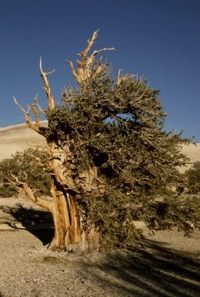
There’s a lot of history packed into a tree with more than 4,000 annual growth rings. Scientists who count them (dendrochronologists) have been able to learn a lot about the drought history of California and the West.
The Great Basin bristlecone pines that grow along the spine of the Sierra are the oldest living things on Earth–older, even, than the giant sequoias. Studying the uppermost trees, around 12,000 ft., researchers stumbled on a strange trend. The trees, legendary for their slow rate of growth, have been growing faster over the last 50 years or so, than at any time in the last three millennia.
If you missed it this week, Malcolm Hughes, one of the study’s lead researchers and a professor of dendrochronology at the University of Arizona’s Laboratory for Tree-Ring Research, spoke to NPR’s All Things Considered about the possible cause.
There’s more on the study in a recent post on the RealClimate blog.
You can see these astonishing trees for yourself in the Ancient Bristlecone Pine Forest of Inyo National Forest–but you might want to wait until spring. The visitor center is not staffed between November and May and winter access is iffy at 10,000 feet. Worse yet, the original vistor center burned down in the fall of last year. The Forest Service is using a temporary (trailer) facility until a permanent one is rebuilt. According to the Forest Service website:
“…the visitor center is being designed to be a model of energy efficiency, utilizing the latest in “green” building practices. According to Bristlecone Pine Forest Manager John Louth, some of the improvements that visitors will see will be a state-of-the art solar power system, updated exhibits addressing the impacts of global warming on the ancient trees, a small research library, a slightly larger theatre room and a fire/intrusion detection & suppression system.”
4 thoughts on “Thousand-Year-Old Trees Get a Growth Spurt”
Comments are closed.

I have recently read that there are some 9,000 year old fir trees living in the northern part of Sweden.
Can you validate that?
Thanks
The Tree Man of Fallbrook, Ca.
Another good catch by a CW blog reader! My information came from Conifers of California (Lanner, 2002) and the US Forest Service, whose website still makes the claim that the Great Basin bristlecones are the world’s oldest trees. However, just as you point out, in April of 2008 (and no, not on April 1), various accounts appeared of the discovery of Swedish firs that were verified by carbon-14 dating to be about 9,000 years old. The discovery was reported by Science Daily (linked above), as well as the London Telegraph, among others. Thanks for the note, Tree Man.
I didn’t realize such old trees grew any more. I just assumed they’d grown as much as they were going to and that’s that. I really love old trees. I like to imagine what they would be able to tell us of history if they could talk.
Chris
Based on a query I sent out to some experts, there now appears to be some question of which trees should actually be counted as oldest. I’ll be posting a follow-up this week, as it looks like Tree Man has opened quite the Pandora’s box.